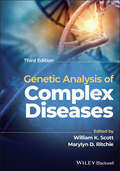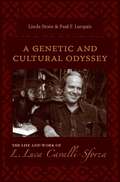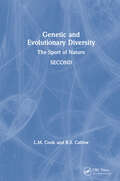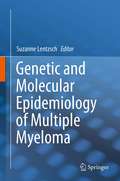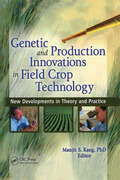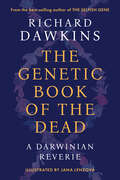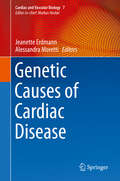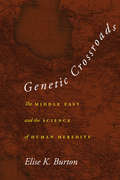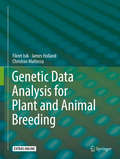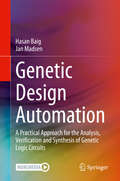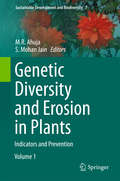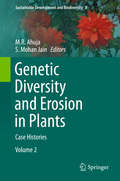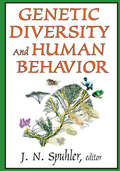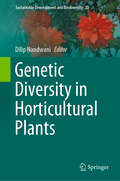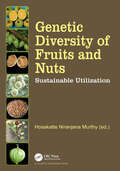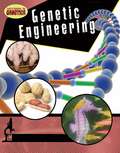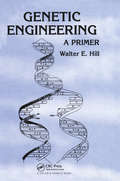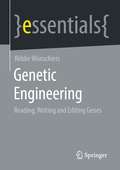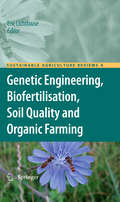- Table View
- List View
Genetic Analysis of Complex Disease
by William K. Scott Marylyn D. RitchieGenetic Analysis of Complex Diseases An up-to-date and complete treatment of the strategies, designs and analysis methods for studying complex genetic disease in human beings In the newly revised Third Edition of Genetic Analysis of Complex Diseases, a team of distinguished geneticists delivers a comprehensive introduction to the most relevant strategies, designs and methods of analysis for the study of complex genetic disease in humans. The book focuses on concepts and designs, thereby offering readers a broad understanding of common problems and solutions in the field based on successful applications in the design and execution of genetic studies. This edited volume contains contributions from some of the leading voices in the area and presents new chapters on high-throughput genomic sequencing, copy-number variant analysis and epigenetic studies. Providing clear and easily referenced overviews of the considerations involved in genetic analysis of complex human genetic disease, including sampling, design, data collection, linkage and association studies and social, legal and ethical issues. Genetic Analysis of Complex Diseases also provides: A thorough introduction to study design for the identification of genes in complex traits Comprehensive explorations of basic concepts in genetics, disease phenotype definition and the determination of the genetic components of disease Practical discussions of modern bioinformatics tools for analysis of genetic data Reflecting on responsible conduct of research in genetic studies, as well as linkage analysis and data management New expanded chapter on complex genetic interactions This latest edition of Genetic Analysis of Complex Diseases is a must-read resource for molecular biologists, human geneticists, genetic epidemiologists and pharmaceutical researchers. It is also invaluable for graduate students taking courses in statistical genetics or genetic epidemiology.
A Genetic and Cultural Odyssey: The Life and Work of L. Luca Cavalli-Sforza
by Stone Linda Paul F. LurquinDrawing links between genetic and cultural development, Cavalli-Sforza developed groundbreaking techniques to trace the evolution of Homo sapiens and the origins of human differentiation, in addition to his earlier work in bacterial genetics. He is also the founder of the Human Genome Diversity Project and continues to work as the principal investigator at Stanford University's Human Population Genetics Laboratory. Based on extensive research and interviews with Cavalli-Sforza and his colleagues, this biography examines the scientist's life and his immense and occasionally controversial contributions to genetics, anthropology, and linguistics.
A Genetic and Cultural Odyssey: The Life and Work of L. Luca Cavalli-Sforza
by Linda StoneDrawing links between genetic and cultural development, Cavalli-Sforza developed groundbreaking techniques to trace the evolution of Homo sapiens and the origins of human differentiation, in addition to his earlier work in bacterial genetics. He is also the founder of the Human Genome Diversity Project and continues to work as the principal investigator at Stanford University's Human Population Genetics Laboratory. Based on extensive research and interviews with Cavalli-Sforza and his colleagues, this biography examines the scientist's life and his immense and occasionally controversial contributions to genetics, anthropology, and linguistics.
Genetic and Evolutionary Computation
by Stefano Cagnoni Stephen L. SmithGenetic and Evolutionary Computation: Medical Applications provides an overview of the range of GEC techniques being applied to medicine and healthcare in a context that is relevant not only for existing GEC practitioners but also those from other disciplines, particularly health professionals. There is rapidly increasing interest in applying evolutionary computation to problems in medicine, but to date no text that introduces evolutionary computation in a medical context. By explaining the basic introductory theory, typical application areas and detailed implementation in one coherent volume, this book will appeal to a wide audience from software developers to medical scientists.Centred around a set of nine case studies on the application of GEC to different areas of medicine, the book offers an overview of applications of GEC to medicine, describes applications in which GEC is used to analyse medical images and data sets, derive advanced models, and suggest diagnoses and treatments, finally providing hints about possible future advancements of genetic and evolutionary computation in medicine.Explores the rapidly growing area of genetic and evolutionary computation in context of its viable and exciting payoffs in the field of medical applications.Explains the underlying theory, typical applications and detailed implementation.Includes general sections about the applications of GEC to medicine and their expected future developments, as well as specific sections on applications of GEC to medical imaging, analysis of medical data sets, advanced modelling, diagnosis and treatment.Features a wide range of tables, illustrations diagrams and photographs.
Genetic and Evolutionary Diversity: The Sport of Nature
by Dr Robert Callow Dr Laurence CookThis book examines the causes of genetic diversity within and between populations, species formation and multiplication and the association of species in communities. It also discusses reproductive patterns in relation to the integrated control of breeding systems and chromosomes behaviour. The ideas presented link fields of biology usually treated separately, which are relevant to population genetic, cytogenetic , ecological and evolutionary studies.This revised edition includes significant advances in the fields of plant genetics and cytogenetics and a greater emphasis on long term evolutionary processes.
Genetic and Molecular Epidemiology of Multiple Myeloma
by Suzanne LentzschMultiple myeloma is a plasma cell malignancy characterized by complex heterogenous cytogenetic abnormalities that accounts for 1.4% of all cancers, and approximately 10% of hematologic malignancies. The clinical manifestations of multiple myeloma include lytic bone lesions, cytopenia, hypercalcemia, renal dysfunction, hyperviscosity of the blood, immunodeficiency, and peripheral neuropathy. Based on the clinical and genetic data, probably all cases of multiple myeloma arise from an asymptomatic monoclonal gammopathy of unknown significance. The exact mechanism of the transition from MGUS to overt multiple myeloma is still not well understood. Recent oncogenomic studies have further advanced our understanding of the molecular pathogenesis of multiple myeloma. This book will give a comprehensive overview of the genetic and molecular epidemiology of multiple myeloma in order to get a more refined and conclusive understanding of this disease.
Genetic and Production Innovations in Field Crop Technology: New Developments in Theory and Practice
by Manjit S. KangGet cutting-edge information to improve crop breeding and productivity!Crop improvement will become progressively important over the next few decades as the world’s population is expected to top 10 billion people, with more than eight billion in developing countries alone. Genetic and Production Innovations in Field Crop Technolog
Genetic Association Studies: Background, Conduct, Analysis, Interpretation
by Mehmet Tevfik DorakGenetic Association Studies is designed for students of public health, epidemiology, and the health sciecnes, covering the main principles of molecular genetics, population genetics, medical genetics, epidemiology and statistics. It presents a balanced view of genetic associations with coverage of candidate gene studies as well as genome-wide association studies. All aspects of a genetic association study are included, from the lab to analysis and interpretation of results, but also bioinformatics approaches to causality assessment. The role of the environment in genetic disease is also highlighted. Genetic Association Studies will enable readers to understand and critique genetic association studies and set them on the way to designing, executing, analyzing, interpreting, and reporting their own.
The Genetic Book of the Dead: A Darwinian Reverie
by Richard DawkinsFrom a renowned biologist and best-selling author, a whole new way of looking at living organisms: reading them as documents describing ancient worlds A Financial Times Best Book of 2024: Science • Named Science Book of the Year by Times (UK) • A Guardian Best Ideas Book of 2024 “Intellectually sparkling and beautifully crafted.”—Adrian Woolfson, Wall Street Journal “A glorious affair. . . . Arguably [Dawkins’s] most joyous ode to the wonders that evolution has wrought in the animal world.”—Philip Ball, Science An exquisitely camouflaged lizard has a desiccated landscape of sand and stones “painted” on its back. Its skin can be read as a description of an ancient desert, a world in which its ancestors survived. Such descriptions are more than skin deep, however. They penetrate the very warp and woof of the entire animal. In this groundbreaking exploration of the power of Darwinian evolution and what it can reveal about the past, Richard Dawkins shows how the body, behavior, and genes of every living creature can be read as a book—an archive of the worlds of its ancestors. In the future, a zoologist presented with a hitherto unknown animal will be able to decode its ancestral history, to read its unique “book of the dead.” Such readings are already uncovering the remarkable ways animals overcome obstacles, adapt to their environments, and, again and again, develop remarkably similar ways of solving life’s problems. From the author of The Selfish Gene comes a revolutionary, richly illustrated book that unlocks the door to a past more vivid, nuanced, and fascinating than anything we have seen.
Genetic Causes of Cardiac Disease (Cardiac and Vascular Biology #7)
by Jeanette Erdmann Alessandra MorettiThis book provides a comprehensive summary of the latest developments in the field of the genomics of cardiac disease. Written and edited by leading clinicians and scientists involved in the analysis and therapy of genetic cardiac disorders, it discusses the genetic causes of a variety of cardiac diseases, such as the complex genetics and etiology of congenital heart diseases. It also explores sex differences in prevalent diseases, genetics-based therapeutic strategies and the use of various animal models and alternatives. The book is intended for research scientists and clinical scientists in the cardiovascular field, human geneticists and cardiologists.
Genetic Counseling Practice
by Bonnie S. Leroy Patricia M. Veach Dianne M. BartelsThe first advanced-level genetics counseling skills resourceAs genetic medicine and testing continue to expand, so the role of the genetic counselor is transforming and evolving. Genetic Counseling Practice: Advanced Concepts and Skills is the first text to address ways that genetic counselors can deepen their skills to meet expanding practice demands. This timely resource not only helps readers further develop their abilities to gather relevant data and interpret it for patients, it also aids them in surpassing their usual role by truly understanding patient situations, incorporating patient values into clinical practice, providing in-depth support, and facilitating thoroughly informed, autonomous decisions.Edited by an expert cross-disciplinary team consisting of a genetic counseling program director, a licensed psychologist, and a nurse/bioethicist/family social scientist, this authoritative reference provides specific and detailed instruction in addressing psychosocial aspects of genetic counseling practice and professional development and training issues of genetic counselors.Provides a process view of genetic counselor service provision; i.e., skills that promote desired genetic counseling outcomes are emphasized (such as relationship skills, patient characteristics, client behaviors, and extra-clinical skills)Includes experiential activities in every chapter to help readers apply concepts and skillsDraws on the experience of widely recognized experts in genetic counseling theory, practice, and research, who serve as chapter authorsFeatures numerous specific, real-life examples from clinical practiceGenetic Counseling Practice addresses issues relevant to practicing genetic counselors as well as students of genetic counseling programs. In addition, oncology nurses, social workers, and psychologists working with genetic counseling patients and families; medical geneticists and physicians training in the field; and physician assistants will also benefit from this resource.
Genetic Crossroads: The Middle East and the Science of Human Heredity
by Elise K. BurtonThe Middle East plays a major role in the history of genetic science. Early in the twentieth century, technological breakthroughs in human genetics coincided with the birth of modern Middle Eastern nation-states, who proclaimed that the region's ancient history—as a cradle of civilizations and crossroads of humankind—was preserved in the bones and blood of their citizens. Using letters and publications from the 1920s to the present, Elise K. Burton follows the field expeditions and hospital surveys that scrutinized the bodies of tribal nomads and religious minorities. These studies, geneticists claim, not only detect the living descendants of biblical civilizations but also reveal the deeper past of human evolution. Genetic Crossroads is an unprecedented history of human genetics in the Middle East, from its roots in colonial anthropology and medicine to recent genome sequencing projects. It illuminates how scientists from Turkey to Yemen, Egypt to Iran, transformed genetic data into territorial claims and national origin myths. Burton shows why such nationalist appropriations of genetics are not local or temporary aberrations, but rather the enduring foundations of international scientific interest in Middle Eastern populations to this day.
Genetic Data Analysis for Plant and Animal Breeding
by Fikret Isik James Holland Christian MalteccaThis book fills the gap between textbooks of quantitative genetic theory, and software manuals that provide details on analytical methods but little context or perspective on which methods may be most appropriate for a particular application. Accordingly this book is composed of two sections. The first section (Chapters 1 to 8) covers topics of classical phenotypic data analysis for prediction of breeding values in animal and plant breeding programs. In the second section (Chapters 9 to 13) we provide the concept and overall review of available tools for using DNA markers for predictions of genetic merits in breeding populations. With advances in DNA sequencing technologies, genomic data, especially single nucleotide polymorphism (SNP) markers, have become available for animal and plant breeding programs in recent years. Analysis of DNA markers for prediction of genetic merit is a relatively new and active research area. The algorithms and software to implement these algorithms are changing rapidly. This section represents state-of-the-art knowledge on the tools and technologies available for genetic analysis of plants and animals. However, readers should be aware that the methods or statistical packages covered here may not be available or they might be out of date in a few years. Ultimately the book is intended for professional breeders interested in utilizing these tools and approaches in their breeding programs. Lastly, we anticipate the usage of this volume for advanced level graduate courses in agricultural and breeding courses.
Genetic Design Automation: A Practical Approach for the Analysis, Verification and Synthesis of Genetic Logic Circuits
by Hasan Baig Jan MadsenThis textbook introduces readers to the recent advances in the emerging field of genetic design automation (GDA). Starting with an introduction and the basic concepts of molecular biology, the authors provide an overview of various genetic design automation tools. The authors then present the DVASim tool (Dynamic Virtual Analyzer and Simulator) which is used for the analysis and verification of genetic logic circuits. This includes methods and algorithms for the timing and threshold value analyses of genetic logic circuits. Next, the book presents the GeneTech tool (A technology mapping tool for genetic circuits) and the methods developed for optimization, synthesis, and technology mapping of genetic circuits. Chapters are followed by exercises which give readers hands-on practice with the tools presented. The concepts and algorithms are thoroughly described, enabling readers to improve the tools or use them as a starting point to develop new tools. Both DVASim and GeneTech are available from the developer’s website, free of charge. This book is intended for a multidisciplinary audience of computer scientists, engineers and biologists. It provides enough background knowledge for computer scientists and engineers, who usually do not have any background in biology but are interested to get involved in this domain. This book not only presents an accessible basic introduction to molecular biology, it also includes software tools which allow users to perform laboratory experiments in a virtual in-silico environment. This helps newbies to get a quick start in understanding and developing genetic design automation tools. The third part of this book is particular useful for biologists who usually find it difficult to grasp programming and are reluctant to developing computer software. They are introduced to the graphical programming language, LabVIEW, from which they can start developing computer programs rapidly. Readers are further provided with small projects which will help them to start developing GDA tools.
Genetic Disorders and the Fetus: Diagnosis, Prevention and Treatment
by Aubrey MilunskyGenetic Disorders and the Fetus: Diagnosis, Prevention and Treatment, Eighth Edition is the eagerly awaited new edition of the discipline-leading work that has been at the forefront of diagnosis, prevention, and treatment of fetal genetic disorders for over 36 years. This timely update builds on the foundations of preconception and prenatal genetic counseling and the original pillars of prenatal diagnosis while also providing authoritative coverage of exciting developments in non-invasive genetic testing and rapidly developing molecular techniques. Chapters are once again authored by internationally recognized authorities in the field of prenatal diagnosis. The editors have brought together an invaluable collection of evidence-based facts bolstered by knowledge and decades of experience in the field.
Genetic Diversity and Erosion in Plants
by M. R. Ahuja S. Mohan JainGenetic erosion is the loss of genetic diversity within a species. It can happen very quickly, due to catastrophic events, or changes in land use leading to habitat loss. But it can also occur more gradually and remain unnoticed for a long time. One of the main causes of genetic erosion is the replacement of local varieties by modern varieties. Other causes include environmental degradation, urbanization, and land clearing through deforestation and brush fires. In order to conserve biodiversity in plants, it is important to targets three independent levels that include ecosystems, species and genes. Genetic diversity is important to a species' fitness, long-term viability, and ability to adapt to changing environmental conditions. Chapters in this book are written by leading geneticists, molecular biologists and other specialists on relevant topics on genetic erosion and conservation genetic diversity in plants. This divisible set of two volumes deals with a broad spectrum of topics on genetic erosion, and approaches to biodiversity conservation in crop plants and trees. Volume 1 deals with indicators and prevention of genetic erosion, while volume 2 covers genetic diversity and erosion in a number of plants species. These two volumes will also be useful to botanists, biotechnologists, environmentalists, policy makers, conservationists, and NGOs working to manage genetic erosion and biodiversity.
Genetic Diversity and Erosion in Plants
by S. Mohan Jain M. R. AhujaGenetic erosion is the loss of genetic diversity within a species. It can happen very quickly, due to catastrophic events, or changes in land use leading to habitat loss. But it can also occur more gradually and remain unnoticed for a long time. One of the main causes of genetic erosion is the replacement of local varieties by modern varieties. Other causes include environmental degradation, urbanization, and land clearing through deforestation and brush fires. In order to conserve biodiversity in plants, it is important to targets three independent levels that include ecosystems, species and genes. Genetic diversity is important to a species' fitness, long-term viability, and ability to adapt to changing environmental conditions. Chapters in this book are written by leading geneticists, molecular biologists and other specialists on relevant topics on genetic erosion and conservation genetic diversity in plants. This divisible set of two volumes deals with a broad spectrum of topics on genetic erosion, and approaches to biodiversity conservation in crop plants and trees. Volume 1 deals with indicators and prevention of genetic erosion, while volume 2 covers genetic diversity and erosion in a number of plants species. These two volumes will also be useful to botanists, biotechnologists, environmentalists, policy makers, conservationists, and NGOs working to manage genetic erosion and biodiversity.
Genetic Diversity and Human Behavior
by J.N. SpuhlerGenetic differences in humans, like those between individuals of any animal or plant species and those between species, are all products of the evolutionary development of the living world. These differences, with their behavioral consequences, can only be understood in the light of evolution. Our understanding of evolution, however, has itself evolved. The Darwin- Wallace theory of evolution appeared in the nineteenth century. Since then, development of evolutionary thought has gone through several stages. The contributions in this volume describe those stages.
Genetic Diversity in Horticultural Plants (Sustainable Development and Biodiversity #22)
by Dilip NandwaniThis book in the series “Sustainable Development and Biodiversity” contains peer-reviewed chapters from leading academicians and researchers around the world in the field of horticulture, plant taxonomy, plant biotechnology, genetics and related areas of biodiversity science centered on genetic diversity. This book includes original research reviews (national, regional and global) and case studies in genetic diversity in fruits and vegetables, horticulture, and ecology from sub-tropical and tropical regions.It is unique as it covers a wide array of topics covering global interests and will constitute valuable reference material for students, researchers, extension specialists, farmers and certification agencies who are concerned with biodiversity, ecology and sustainable development.
Genetic Diversity of Fruits and Nuts: Sustainable Utilization
by Hosakatte Niranjana MurthyGenetic Diversity of Fruits and Nuts: Sustainable Utilization presents an account of the diversity and possible exploitation of such variability in the improvement of varied fruits and nuts of the world. Expert authors in the field have addressed the significance of fruit and nut crops’ genetic variability for their sustainable exploitation to develop new cultivars that can cater to growers' needs, adapt to climate change, and address the rising need for food.
Genetic Engineering (Let's Relate to Genetics #4)
by Marina CohenDiscusses current and potential uses of genetic engineering in fields such as medicine, criminal investigation, and agriculture and examines some of the ethical questions involved. <P><P>Lexile Measure: 840L
Genetic Engineering: A Primer
by Walter E. HillGenetic Engineering: A Primer presents the growing field of biotechnology to non-science majors and other general interest readers. The author examines the natural forces that change genetic information and the ways in which scientists have learned to engineer these genetic changes. With a wealth of information flooding the popular press, including
Genetic Engineering: Reading, Writing and Editing Genes (essentials)
by Röbbe WünschiersThis essential should serve as an introduction for a contemporary public discussion on genetic engineering. Genetic engineering affects us all in many areas and we must dare to think more colorful and further. In fact, the complete genetic material of viruses and bacteria can already be chemically produced and "brought to life". With genetic surgery, medicine is at a crossroads: do we want to treat hereditary diseases or "repair" them genetically? And the analysis of thousands of human genetic material reveals information that is related to complex diseases, but also to characteristics such as intelligence. How should we use this knowledge? The question is hardly whether we want genetic engineering, but rather how we use it.This Springer essential is a translation of the original German 1st edition essentials, Gentechnik by Röbbe Wünschiers, published by The Editor(s) (if applicable) and The Author(s), under exclusive license to Springer Fachmedien Wiesbaden GmbH, part of Springer Nature in 2019. The translation was done with the help of artificial intelligence (machine translation by the service DeepL.com). A subsequent human revision was done primarily in terms of content, so that the book will read stylistically differently from a conventional translation. Springer Nature works continuously to further the development of tools for the production of books and on the related technologies to support the authors.
Genetic Engineering and Biotechnology: Concepts, Methods and Agronomic Applications
by Yves TourteIntroductory text for students of genetics is general and the students of agronomy as the book gives numerous agronomic applications.
Genetic Engineering, Biofertilisation, Soil Quality and Organic Farming
by Eric LichtfouseSustainable agriculture is a rapidly growing field aiming at producing food and energy in a sustainable way for humans and their children. Sustainable agriculture is a discipline that addresses current issues such as climate change, increasing food and fuel prices, poor-nation starvation, rich-nation obesity, water pollution, soil erosion, fertility loss, pest control, and biodiversity depletion. Novel, environmentally-friendly solutions are proposed based on integrated knowledge from sciences as diverse as agronomy, soil science, molecular biology, chemistry, toxicology, ecology, economy, and social sciences. Indeed, sustainable agriculture decipher mechanisms of processes that occur from the molecular level to the farming system to the global level at time scales ranging from seconds to centuries. For that, scientists use the system approach that involves studying components and interactions of a whole system to address scientific, economic and social issues. In that respect, sustainable agriculture is not a classical, narrow science. Instead of solving problems using the classical painkiller approach that treats only negative impacts, sustainable agriculture treats problem sources. Because most actual society issues are now intertwined, global, and fast-developing, sustainable agriculture will bring solutions to build a safer world. This book series gathers review articles that analyze current agricultural issues and knowledge, then propose alternative solutions. It will therefore help all scientists, decision-makers, professors, farmers and politicians who wish to build a safe agriculture, energy and food system for future generations.
